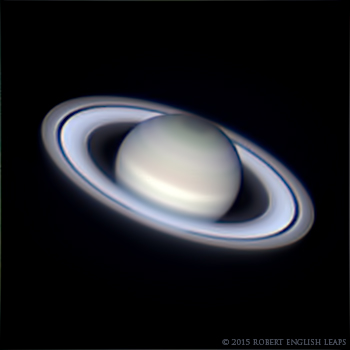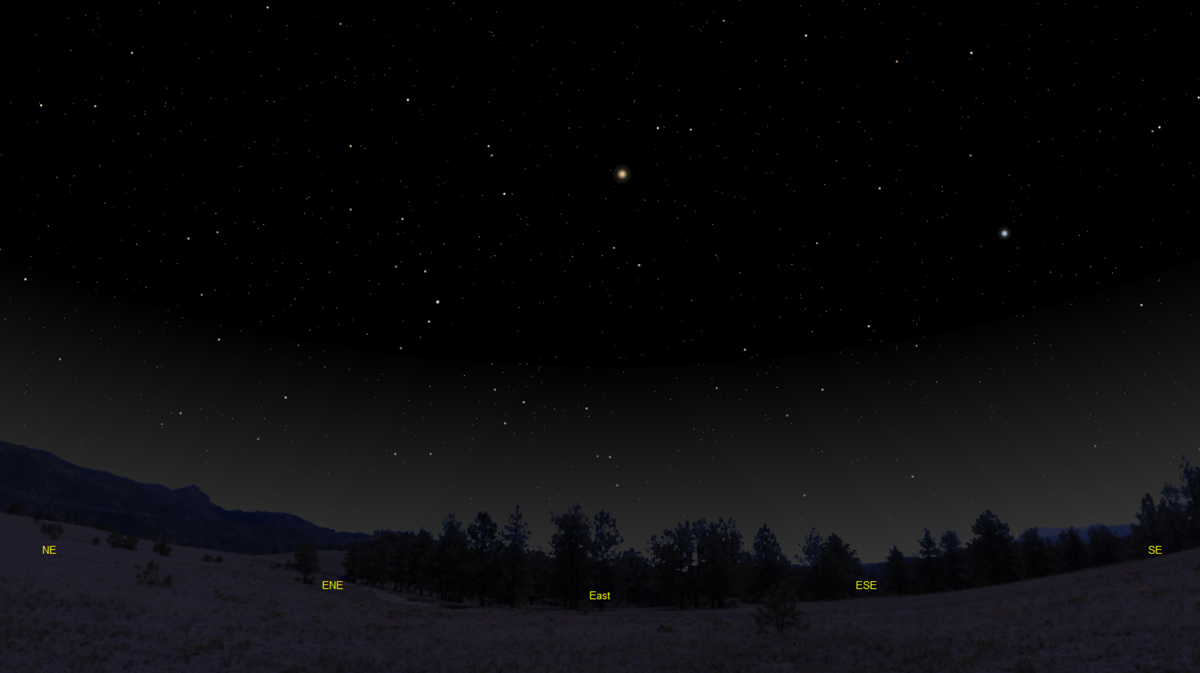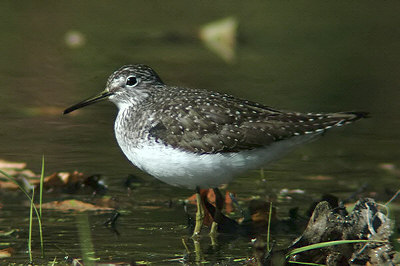The purpose of this feature is to give scout leaders, educators and naturalists an idea of some of the natural events coming up each month. We will try to cover a variety of natural events ranging from sky events to calling periods of amphibians, bird and mammal watching tips, prominent wildflowers and anything else that comes to mind. We will also note prominent constellations appearing over the eastern horizon at mid-evening each month for our area for those who would like to learn the constellations. If you have suggestions for other types of natural information you would like to see added to this calendar, let us know! Note: You can click on the hyperlinks to learn more about some of the featured items. To return to the Calendar, hit the "back" button on your browser, NOT the "back" button on the web page. All charts are available in a "printer friendly" mode, with black stars on a white background. Left clicking on each chart will take you to a printable black and white image. Please note that images on these pages are meant to be displayed at 100%. If your browser zooms into a higher magnification than that, the images may lose quality. Though we link book references to nationwide sources, we encourage you to support your local book store whenever possible.
Notes and Images From March and Early April 2016 We conducted a mammal bioblitz at the Owl's Hill Nature Sanctuary on March 19th. We used a combination of live traps, scent stations and pit traps to survey the property. We had a spectacular view of a bobcat when we were setting out the traps at dusk the day before the blitz. We came around a bend in a trail and spotted it quite close. It froze for about ten seconds, long enough that I got a wonderful view in my 8x30 binoculars. Among other species on the blitz we found a number of white-footed deer-mice, Peromyscus leucopus, in two areas. We photographed the one below just before releasing it back into the wild.
The genus name, Peromyscus, means "pouched little mouse." The species name, leucopus, means "white-footed." Habitats include wooded areas, brushy or weedy borders, and fence rows. Most of the white-footed deer-mice we found seemed to have found a home in one of the old rock walls at Owl's Hill. According to Charles and Elizabeth Schwartz (The Wild Mammals of Missouri) these deer-mice also spend a large part of their lives in trees. They have been observed voluntarily swimming relative long distances (hundreds of feet) from one island to another. In winter, according to the Schwartz's, they become less aggressive and more communal as food supplies are lower, and their foraging range diminishes. "What about your supplies, Frederick?"*
For some time we've been wanting to get a full size sensor camera for wide-field night sky imaging. I have enough Nikon lenses that it would be impractical to change manufacturers now, so I knew it would be a Nikon. After surveying the current Nikons, I ended up buying a Nikon D750. The shot below was made about 5:00am on April 3rd and shows the bright star Antares, Mars, Saturn and the Milky Way. A waning crescent Moon was above the horizon in the east. Two Barred Owls called while I was imaging. A binocular comet, 252P/Linear, is also in the field of view. Click the image below to see a labeled view, including the location of the comet. Day to day positions of the comet can viewed in the Sky Safari app recommended below. *Frederick, Leo Leonni, 1967 Sky Events for April 2016: The Lyrid Meteor Shower peaks on the morning of April 22nd at 1:00am CDT, but a full Moon will hamper observations. Evening Sky:
Mercury has its best apparition of the year this month, reaching greatest elongation from the Sun on April 18th. It should be visible about 45 minutes after sunset for most of the rest of the month, before slipping back into the twilight glow.At the beginning of the month, look for Jupiter low in the eastern sky. The great planet remains in Leo this month. To get good telescopic views, wait until it is high in the sky. This month is a great time to see Jupiter and its cloud belts. Mars is in Scorpius as the month begins, rising about 11:24pm CDT. The planet's apparent diameter is growing larger as we near its closest approach to Earth in May. At the beginning of the month it's 11.8 arc-seconds in diameter, but grows to 16 arc-seconds by month's end. This means that Mars will appear larger than it has in a decade. This will allow more and more detail to be seen as the month goes on. Mars is always fascinating to view, but it takes patience to wait for the moments when the Earth's atmosphere steadies. At these times you get fleeting glimpses of the fainter surface details. Watch for the planet to brighten a lot over the next three months till it blazes like a red coal. The bright star Antares is also close by. Antares means, "rival of Mars" and this is a great chance to compare the two. Morning Sky:
Saturn is in Ophiuchus, rising just after midnight at the beginning of the month. The tilt of the rings has now opened to 26 degrees, and the view is spectacular in any size telescope. Your best views will be just before sunrise. Saturn is not far from Mars in the night sky this month, and they make a striking pair.
Constellations: The views below show the sky looking east at 9:30pm CDT on April 15th. The first view shows the sky with the constellation outlined and names depicted. Star and planet names are in green. Constellation names are in blue. The second view shows the same scene without labels. Bright objects in the eastern sky this month include the stars Arcturus and Spica. New constellations are Serpens Caput, the Serpent (Head), and Hercules, the Strongman. As spring progresses and Hercules rises higher in the sky, look for the globular cluster Messier 13 (M13), which appears like a small fuzzy patch of light about 1/3 of the distance from Eta to Zeta Hercules (see illustration below). A cluster of stars about 21,000 light years away, M13 can be made out with the naked eye in a dark country sky when the constellation is high in the sky. Binoculars will help pick it out. On Learning the Constellations: We advise learning a few constellations each month, and then following them through the seasons. Once you associate a particular constellation coming over the eastern horizon at a certain time of year, you may start thinking about it like an old friend, looking forward to its arrival each season. The stars in the evening scene above, for instance, will always be in the same place relative to the horizon at the same time and date each April. Of course, the planets do move slowly through the constellations, but with practice you will learn to identify them from their appearance. In particular, learn the brightest stars (Like Arcturus and Spica in the above scene looking east), for they will guide you to the fainter stars. Once you can locate the more prominent constellations, you can "branch out" to other constellations around them. It may take you a little while to get a sense of scale, to translate what you see on the computer screen or what you see on the page of a book to what you see in the sky. Look for patterns, like the stars that make up the constellation Corona Borealis. The earth's rotation causes the constellations to appear to move across the sky just as the sun and the moon appear to do. If you go outside earlier than the time shown on the charts, the constellations will be lower to the eastern horizon. If you observe later, they will have climbed higher. As each season progresses, the earth's motion around the sun causes the constellations to appear a little farther towards the west each night for any given time of night. If you want to see where the constellations in the above figures will be on May 15th at 9:30pm CDT, you can stay up till 11:30am CDT on the April 15th and get a preview. The westward motion of the constellations is equivalent to two hours per month. Recommended: Sky & Telescope's Pocket Star Atlas is beautiful, compact star atlas. A good book to learn the constellations is Patterns in the Sky, by Hewitt-White. You may also want to check out at H. A. Rey's classic, The Stars, A New Way to See Them. For skywatching tips, an inexpensive good guide is Secrets of Stargazing, by Becky Ramotowski. A good general reference book on astronomy is the Peterson
Field Guide,
A Field Guide to the Stars and Planets, by Pasachoff. The book retails for around $14.00. The Virtual Moon Atlas is a terrific way to learn the surface features of the Moon. And it's free software. You can download the Virtual Moon Atlas here. Cartes du Ciel (described in the monthly notes above) is a great program for finding your way around the sky. It is also free, and can be downloaded here. Apps: We really love the Sky Safari Pro application described here. For upcoming events, the Sky Week application is quite nice. Both apps are available for both I-phone and Android operating systems. The newest version, Sky Safari 4, is available here. A nother great app is the Photographer's Ephemeris. Great for finding sunrise, moonrise, sunset and moonset times and the precise place on the horizon that the event will occur. Invaluable not only for planning photographs, but also nice to plan an outing to watch the full moon rise. Available for both androids and iOS.
Amphibians:
In addition to earlier breading species like Upland Chorus Frogs, Spring Peepers, Southern Leopard Frogs, and American Toads, listen for Fowler's Toads, Eastern Cricket Frogs and Gray Treefrogs. The early calls of Gray Treefrogs sound raspier than the normal trill, as if the frog needs to clear its throat. A fairly new arrival to our area is the Green Treefrog. Don't be too surprised if you see or hear one. Listen also on warm days for American Bullfrogs and Green Frogs. Early April is also a great time to listen for the "yeeooww" calls of Pickerel Frogs. Recommended: The Frogs and Toads of North America, Lang Elliott, Houghton Mifflin Co.
Birds:
The spring migration builds very quickly in April. The neo-tropical migrants are too numerous to list here, but now is the time to get out in the early morning with a pair of binoculars and welcome the new arrivals for the day. Scan the edges of ponds and creeks for Solitary and Spotted Sandpipers. Early arrivals also include Black-and-white Warbler, Black-Throated Green Warbler, Louisiana Waterthrush and Blue-gray Gnatcatcher. We had a Louisiana Waterthrush on March 20th this year. Listen at dusk for young Great Horned Owls and Young Barred Owls, doing their raspy "begging" calls. Recommended: The Sibley Guide to Birds, David Allen Sibley The Sibley Guide to Birds of Eastern North America, David Allen Sibley An inexpensive guide for beginners is the Golden Guide for Birds.
Wildflowers: Some of our favorite Spring wildflower walks are: The south ridge at the Owl's Hill Nature Center in Brentwood, Tennessee. The Angel Falls trail along the Cumberland River at the Big South Fork Recreational Area, near Jamestown, Tennessee.
Archives (Remember to use the back button on your browser, NOT the back button on the web page!) Natural Calendar February 2016 Natural Calendar December 2015 Natural Calendar November 2015 Natural Calendar November 2014 Natural Calendar September 2014 Natural Calendar February 2014 Natural Calendar December 2013 Natural Calendar September 2013 Natural Calendar December 2012 Natural Calendar November 2012 Natural Calendar September 2012 Natural Calendar February 2012 Natural Calendar December 2011 Natural Calendar November 2011 Natural Calendar September 2011 Natural Calendar December 2010 Natural Calendar November 2010 Natural Calendar September 2010 Natural Calendar February 2010 Natural Calendar December 2009 Natural Calendar November 2009 Natural Calendar September 2009 Natural Calendar February 2009 Natural Calendar December 2008 Natural Calendar November 2008 Natural Calendar September 2008 Natural Calendar February 2008 Natural Calendar December 2007 Natural Calendar November 2007 Natural Calendar September 2007 Natural Calendar February 2007 Natural Calendar December 2006 Natural Calendar November 2006 Natural Calendar September 2006 Natural Calendar February 2006 Natural Calendar February 2003 Natural Calendar December 2002 Natural Calendar November 2002 Nature Notes Archives: Nature Notes was a page we published in 2001 and 2002 containing our observations about everything from the northern lights display of November 2001 to frog and salamander egg masses. Night scenes prepared with The Sky Professional from Software Bisque All images and recordings © 2016 Leaps
|
|







